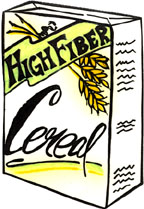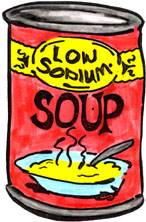|
Click here for the printable (Word) version of the lesson
Descriptive
Terms
 Prior to the Nutrition Labeling
and Education Act, many descriptive terms used on labels were
not regulated. Today, food products using descriptive terms on
food labels must meet strict regulations. Understand that it
isn't important or even possible to memorize all the definitions.
It's only important to know that these terms have strict regulations.
The list below will help you understand what the descriptive
terms mean. Prior to the Nutrition Labeling
and Education Act, many descriptive terms used on labels were
not regulated. Today, food products using descriptive terms on
food labels must meet strict regulations. Understand that it
isn't important or even possible to memorize all the definitions.
It's only important to know that these terms have strict regulations.
The list below will help you understand what the descriptive
terms mean.
Label Language
Just like the Nutrition Facts, nutrient content claims are defined
for one serving. For example, that means that low- fat cheese
has no more than three grams of fat per serving.
Nutrient
Content Claim-Definition per Serving
Calories
Calorie free - less than five calories
Low calorie - 40 calories or less
Reduced or fewer calories - at least 25% fewer
calories*
Light - one-third fewer calories*
Sugar
Sugar free - less than 0.5 gram sugar
Reduced sugar - at least 25% less sugars*
No added sugar - no sugars added during processing
or packing, including ingredients that contain sugars such as
fruit juices, applesauce or dried fruit
Fat
Fat free - less than 0.5 gram
of fat
Low fat - three grams or less of fat
Reduced or less fat - at least 25% less fat*
Light - 50% less fat
Saturated Fat
Saturated fat free - less than 0.5 gram saturated
fat
Low saturated fat - 1 gram or less saturated
fat per serving and not more than 15% of calories from saturated
fat
Reduced or Less saturated fat - at least 25
% less saturated fat*
Cholesterol
Cholesterol free - less than 2 milligrams cholesterol
and 2 grams or less of saturated fat
Low cholesterol - 20 milligrams or less
cholesterol and 2 grams or less of saturated fat
Reduced or less cholesterol - at least
25% less cholesterol and 2 grams or less saturated fat*
Sodium
 Sodium free
- less than 5 milligrams sodium Sodium free
- less than 5 milligrams sodium
Very low sodium - 35 milligrams or less
sodium
Low sodium - 140 milligrams or
less sodium
Reduced or less sodium - at least 25% less sodium*
Light in sodium - 50% or less sodium
Fiber
High fiber - 5 grams or more
Good source of fiber - 2.5 grams to 4.9 grams
More or added fiber - at least 2.5 grams more
fiber
Other Claims
High, rich in, excellent source of - 20% or
more of Daily Value
Good source - provides 10% to 19% of Daily Value
More, enriched, fortified - added 10% or more
of Daily Value
Lean** - Less than 10 grams fat, 4.5 grams saturated
fat and 95 milligrams cholesterol
Extra lean** - Less than 5 grams fat, 2 grams
saturated fat and 95 milligrams cholesterol
* as compared with a standard serving size of the traditional
food
** on meat, poultry, seafood and game meats
If you read carefully, you noticed that reduced means at least
25% less of something than the traditional food. For example,
reduced sodium is 25% less sodium, reduced fat is 25% less fat
and reduced cholesterol is 25% less cholesterol than the traditional
food. This one is easy to remember, but a 25% reduction doesn't
mean it is low in sodium, fat, cholesterol or whatever. You must
read the label.
   [ LESSONS || SITE
MAP || LOCAL AGENTS || RESOURCES || PEOPLE ]
[ LESSONS || SITE
MAP || LOCAL AGENTS || RESOURCES || PEOPLE ]
 Issued in furtherance of Cooperative Extension
work, Acts of Congress of May 8 and June 30, 1914, in cooperation
with the United States Department of Agriculture. The Louisiana
Cooperative Extension Service provides equal opportunities in
programs and employment. Information and Graphics on this site
are copyright protected by LSU Agricultural Center's Louisiana Cooperative Extension Services.
For more information
on the EFNEP program, contact EFNEPMail@agcenter.lsu.edu. Issued in furtherance of Cooperative Extension
work, Acts of Congress of May 8 and June 30, 1914, in cooperation
with the United States Department of Agriculture. The Louisiana
Cooperative Extension Service provides equal opportunities in
programs and employment. Information and Graphics on this site
are copyright protected by LSU Agricultural Center's Louisiana Cooperative Extension Services.
For more information
on the EFNEP program, contact EFNEPMail@agcenter.lsu.edu.
|